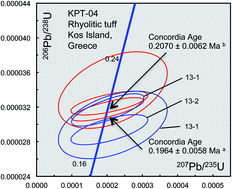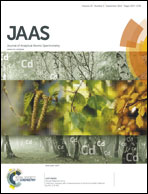U–Pb dating of CA/non-CA treated zircons obtained by LA-ICP-MS and CA-TIMS techniques: impact for their geological interpretation†
Abstract
Chemical Abrasion Isotope-Dilution Thermal Ionization Mass Spectrometry (CA-ID-TIMS) is known as a high precision technique for resolving lead loss and improving the interpretation of U–Pb zircon age data. Here, we argue that combining CA with the widely applied Laser Ablation-Inductively Coupled Plasma-Mass Spectrometry (LA-ICP-MS) improves the precision and accuracy of zircon dates, while removing the substantial parts with lead loss, reducing data scatter, and providing meaningful geological interpretations. The samples are magmatic rocks chosen from different geological time periods (one Paleozoic, one Mesozoic and three Cenozoic). All zircon separates are analysed by LA-ICP-MS before and after CA, and age data are compared with CA-ID-TIMS 206Pb/238U dates that are considered as the most accurately obtainable age. All CA-treated zircon crystals show up to 50% less data scatter compared to the non-CA treated zircon grains and thus reduction of the calculated uncertainties is apparent. The obtained wt average LA-ICP-MS 206Pb/238U ages of the CA-treated zircon grains are up to 4–6% higher than those of the non-CA treated crystals, exceeding the analytical uncertainties of the LA-ICP-MS dating technique of 1–2%. The damaged crystal parts, caused by U-decay, with lead loss are removed, so that we can exclude younging from the possible geological scenarios. CA-LA-ICP-MS age data are in good agreement with the CA-ID-TIMS dates and suggest advantages of using CA-LA-ICP-MS in order to define accurate ages. The use of the CA technique for very young zircons (∼0.2 Ma, Kos rhyolitic tuff, Greece) seems optional; as the obtained mean 206Pb/238U ages of non-CA and CA treated zircons coincide within the uncertainty. The negligible time to produce the lattice damage (based on alpha decay or spontaneous fission) makes lead loss less important for age dating and data interpretation of very young zircons (<1 Ma).

- This article is part of the themed collection: Geological applications of laser ablation

 Please wait while we load your content...
Please wait while we load your content...